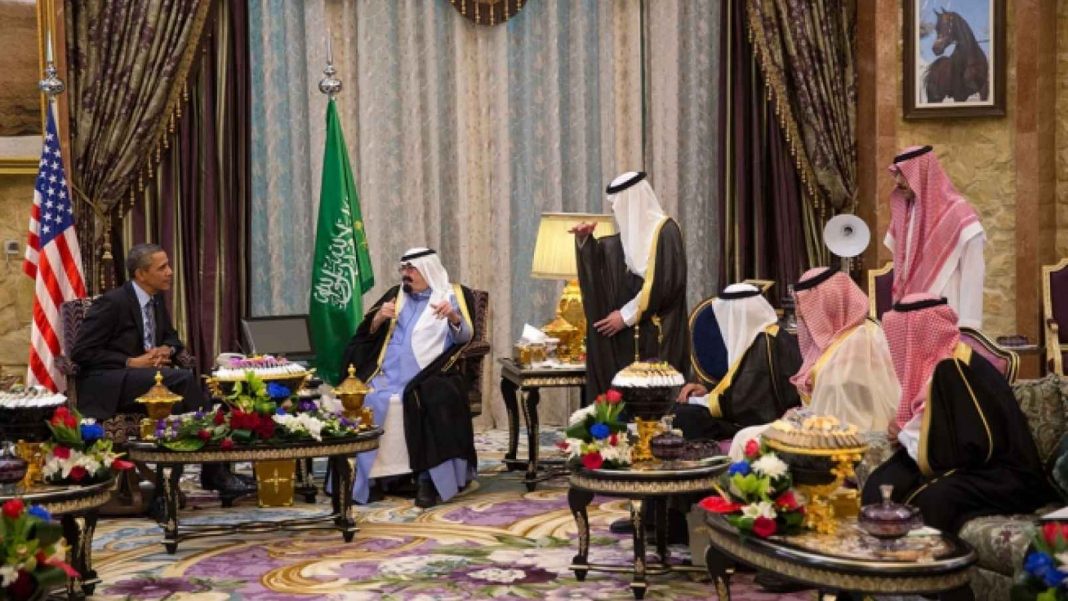The U.S. and Saudi Arabia: A 21st-century partnership
Faisal J. Abbas/Al Arabiya/September 10/15
In Feb. 1945, U.S. President Franklin D. Roosevelt met with King Abdulaziz al-Saud – the founder of modern-day Saudi Arabia – in a historic encounter onboard the USS Quincy over Egyptian waters. That meeting would for seven decades shape the relationship (or rather the alliance) between the United States and Saudi Arabia. This partnership has proved to be paramount not just in terms of “oil in exchange for security” – a reductive dichotomy used by some observers – but for global stability, prosperity and peace.
President Roosevelt listens as Saudi King Abdul Aziz speaks with him in French aboard a U.S. warship in this Feb. 20, 1945. (File photo: AP) Indeed, it was the Saudi-U.S. alliance that helped end Soviet aggression against Muslim lands, and liberated Kuwait from Iraqi occupation. Even when differences emerged (and serious ones did emerge on numerous occasions), the Americans have found their Saudi allies reasonable, calm and open to practical solution. Such attributes – the United States would find throughout the years – are rare in an unstable region plagued with irrational players such as the former Qaddafi regime in Libya, the current Assad regime in Syria, and most importantly the Iranian regime, which regards the United States as the “Great Satan,” and has for decades been involved in state-funded terrorism against America and its allies in the region.
Nuclear deal
The latest disagreement between Riyadh and Washington – and perhaps among the most significant – is the current Iran nuclear deal, which the Obama administration so passionately defends. There is no dispute on the fact that a nuclear-free Iran would mean a safer, more stable world. However, Saudi Arabia and other U.S. Gulf allies are concerned that Iran, despite crippling economic sanctions, has been engaged in aggressively funding, plotting and backing terrorist groups across the region. Even when differences emerged, the Americans have found their Saudi allies reasonable, calm and open to practical solution. Such attributes – the United States would find throughout the years – are rare in an unstable region plagued with irrational players. From the 1979 embassy hostage crisis in Tehran, to the 1983 attack on U.S. marines in Beirut, to supporting terrorist groups and destabilizing forces such as Hezbollah in Lebanon, Hamas in Palestine, Asaaib Ahl al-Haq (AAS) in Iraq, and most recently the Houthis in Yemen; Iran’s malicious fingerprints have been left all over the place. As such, a legitimate question to the Obama administration was: If Iran managed to create all this damage despite sanctions, what guarantees would be introduced to ensure it does not do even more harm once sanctions are lifted?
Infographic: Iran’s funding to terrorist groups all over the region.
There are those on the American side who believe that the Iranians would make a better ally, arguing that they are “strategic”, “not impulsive,” and “respond to costs and benefits,” as President Barack Obama infamously said. Furthermore, and as we all mourn during this 14th anniversary of the atrocious 9/11 terrorist attacks, some analysts believe that Iran makes a better ally because it never attacked America on its own soil, while Osama bin Laden was once a Saudi and many of the hijackers were Saudi. These so-called analysts should read former U.S. Vice President Dick Cheney’s recent comments about how this nuclear deal could provide Iran with the means to launch a nuclear attack on America. More importantly, such idiotic analysis turns a blind eye to the fact that Bin Laden was stripped of his Saudi citizenship long before 9/11, that the hijackers were acting as individuals, and that Al-Qaeda is officially designated a terrorist group in Saudi Arabia. Contrary to Iran, which officially supports terrorism, Saudi authorities track down and punish supporters, fighters and financers of such groups. Iran does not only back Shiite terrorist groups but Sunni ones, such as Al-Qaeda itself. This is not an assumption, but a fact stated in official reports prepared by the U.S. State Department.
A 21st-century partnership
Seventy years after the historic King Abdulaziz–Roosevelt meeting, Saudi King Salman arrived in Washington DC and had an equally historic encounter with Obama last week. In 1945, Saudi Arabia was largely underdeveloped and in need of U.S. help to bring stability to a post-WWII region. One could assume that among the most important take-outs of the USS Quincy meeting was a pledge by Roosevelt not to engage in any activity that would harm the Arab people. However, what was interesting this time around is what King Salman had to say to Obama: “In our country, thank God we are prosperous, but we want prosperity for the entire region. And we are willing to cooperate with you in order to achieve that.”Saudi King Salman in the Oval Office (L) and U.S. President Obama welcoming Mohammad bin Salman to the U.S. (File photos: SPA/Al-Riyadh)
Equally as important was the strategic vision for a 21st-century partnership between the two countries, which was presented by Saudi Crown Prince Mohammad bin Salman during the visit. This vision, which was aided by studies prepared by leading global consultancy groups such as Booz Allen Hamilton and BCG, is estimated to have a potential worth of $2 trillion in 12 sectors. It includes unprecedented steps toward opening up the lucrative Saudi market to U.S. investors and companies. It also creates a space for deepening ties not just through economic opportunity, but via working toward mutual prosperity and good for both peoples, and sharing knowledge and best practices. One only has to compare the good that this Saudi political and business vision could potentially achieve, with the harm caused by the $14-$30 billion Iran spends every year to support regional terrorism (according to a recent report by the Washington Times), to determine that the United States is far better off on the side of its long-term and stability-seeking allies.
Aylan Kurdi’s Europe
Roger Cohen/The New York Times/September 10/15
Oh, Europe, the Mediterranean, cradle of civilization, is a watery grave. At the side of an Austrian highway, 71 nameless refugees perish, asphyxiated in a modern-day boxcar. Czech authorities, armed with indelible markers but bereft of a sense of history, inscribe identification numbers on the skin of 200 migrants. Others are duped by Hungarian police with promises of “freedom” and find themselves in a “reception” camp (where presumably they are offered a shower).’






















